#the six napoleons 1986
Text
my, how the tables have turned
#daily dose of granada holmes#daily granada screencap#*video#sherlock holmes 1984#the six napoleons 1986#jeremy brett holmes#edward hardwicke watson#granada holmes#sherlock holmes#jeremy brett#edward hardwicke#sherlock holmes granada#dr john watson#john watson#acd holmes#acd sherlock holmes#acd watson#acd john watson#acd johnlock#h/w#victorian husbands
442 notes
·
View notes
Text
"Well, Mr. Holmes. l've seen you handle a good many cases in my time, but l don't know that l ever knew a more workman-like one than this."
The Return of Sherlock Holmes (1986) || The Six Napoleons ―Jeremy Brett and Colin Jeavons as Sherlock Holmes and Inspector Lestrade
#granada holmes#jeremy brett#colin jeavons#sherlock holmes#sherlock fandom#inspector lestrade#my life quality has improved tremendously ever since I've discovered this series#and look what happens in the first episode I've ever watched#and marina sirtis was in it too!
458 notes
·
View notes
Text
David Stuart Davies:
As the third series, The Return of Sherlock Holmes, began filming in the summer of 1986, there were no obvious signs of Jeremy's illness. But to those who knew him well there were subtle differences in his demeanour... By the time of The Six Napoleons, the manic depression was taking hold, and colleagues were noting swings in his moods.
Shortly after finishing the first series of The Return, Jeremy was admitted to Maudesley Hospital in South London, well known for its treatment of mental disorders. He was there for about ten weeks.
When he finally came out of hospital, Edward Hardwicke picked him up and took him home where they had a meal with Edward's lovely wife, Prin. In those recuperative weeks, Hardwicke kept a watchful eye on his friend, inviting him home, meeting him for a meal, and ringing him regularly. He behaved, you might say, as Watson would have done towards Holmes.
As a result of this illness there was a delay in filming their first two-hour special, The Sign of Four. While Jeremy had been undergoing the traumas of his mental struggle, the viewing public had remained ignorant, so when The Sign of Four appeared on British television screens in December 1987 there was no erratic behaviour-watching.
By this time, the second series of The Return was filming, and Brett had suffered a second bout of severe manic depression. It was at this period that his hair was cut quite short. 'It was patently obvious it had not been cut by a barber - there were bits sticking up all over,' Hardwicke told me. The make-up department at Granada had to deal with the mangled thatch, as did producer Michael Cox, who, keeping up appearances, suggested that the shortlocks sherlock worked. I was dismayed, as were many other champions of the series. At that time, of course, we were not aware of the seriousness of Brett's illness.
The first episode was 'The Devil's Foot', a tale in which the detective is suffering from exhaustion and depression and is forced to take a holiday in Cornwall. Of course a crime presents itself and Holmes is able to shake off his malaise and solve it, but not before he has a chance to behave rather oddly. There is an air of self-indulgence about Brett's performance. At this time Jeremy was feeling rather 'up', entertaining members of the cast by singing to them at the dinner table in the evening. Jeremy's exuberance while filming 'The Devil's Foot' led him to make additions to the story, some not always in keeping with either Conan Doyle's Holmes or his previous performances...
20 notes
·
View notes
Text


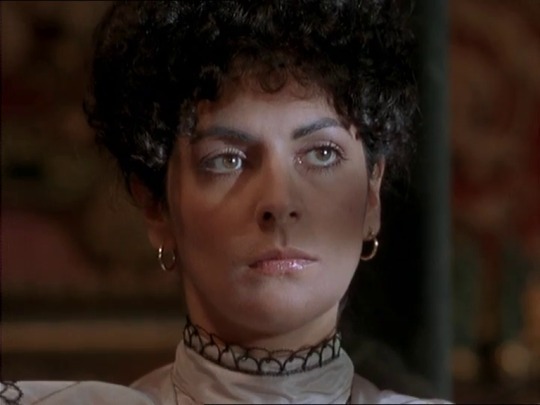





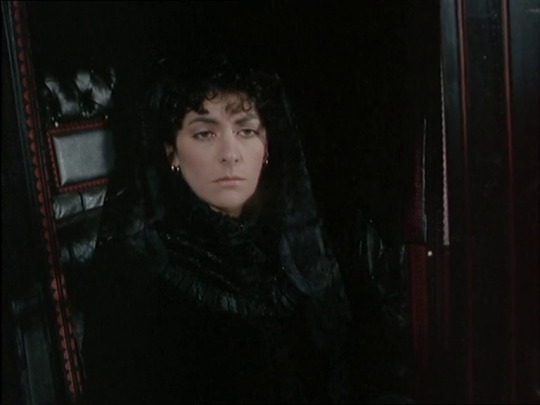
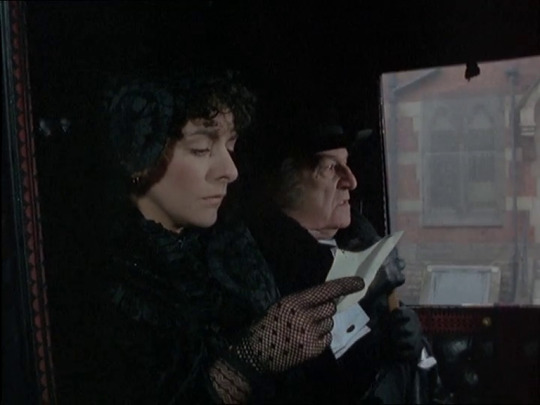
More from the Department of Before They Were Star Trek Stars: Marina Sirtis in THE RETURN OF SHERLOCK HOLMES, episode 7, "The Six Napoleons" (original air date August 20, 1986).
Marina plays an Italian woman involved with the theft of a priceless pearl, which comes to be hidden in one of the titualar plaster busts of Napoleon Bonaparte.
#marina sirtis#star trek#star terk tng#star trek the next generation#sherlock holmes#the return of sherlock holmes#granada holmes#1980s tv#1990s tv
22 notes
·
View notes
Photo



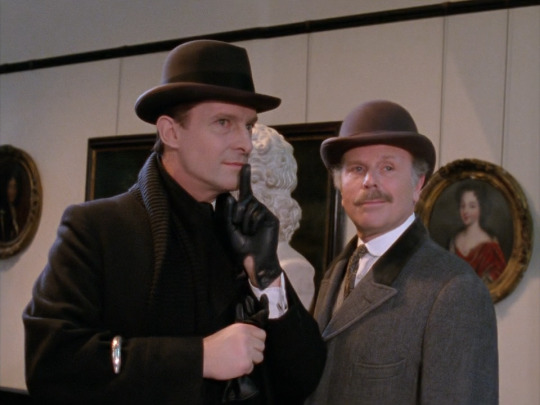

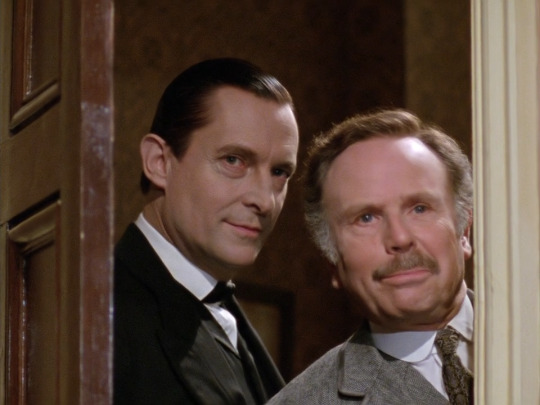
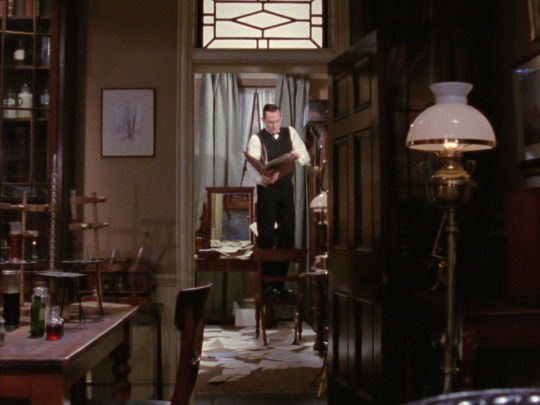

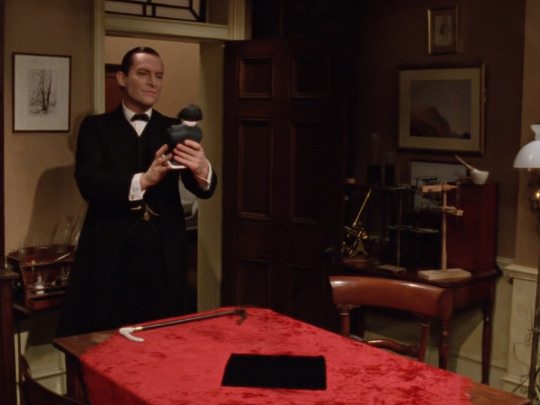

The Six Napoleons (1986)
Эта серия просто потрясающая и не только потому, что это один из самых ярких и узнаваемых рассказов Конан Дойла. Просто этот эпизод по своему духу и каноничности очень напоминает первые два сезона - начиная с третьего, тон и атмосфера сериала начали меняться, будто на нем появилась блеклая патина, и появлялись все большие и большие отхождения от канона. Здесь же - все идеально. Началось все с каноничных посиделок Лестрейда в гостях у Холмса и Уотсона, а потом авторы произвели рокировку реплик из рассказа - и вот уже Уотсон командует Холмсом и велит ему поскорее допивать кофе (Холмс от неожиданности аж поперхнулся). А потом маячил Уотсону на уличный фонарь, стоя под ним, чтобы тот якобы сам дал ответу Лестрейду на его вопрос по делу. Да и вообще тут было столько улыбчивого и смешного Холмса, их переглядок с Уотсоном, что я просто не могу. Ну а чуть ли не кульминацией серии (на самом деле нет) была та презабавнейшая сценка, где Лестрейд дожидался прихода Холмса и Уотсона и украдкой заглядывал в бумаги Холмса, что и заметили вернувшиеся хозяева через дверную щель. Но смущать Лестрейда не стали, тихонько отошли назад и с громкими разговорами и кашлем ворвались в гостиную. А потом Холмс совершенно канонично уложил Лестрейда до вечера баиньки на диване, да и Уотсон отрубился в кресле, пока Холмс, стоя на стуле у себя в комнате, копался в своих бумажках, раскидывая их по полу. Боже ж мой, не устаю радоваться этой серии. Ну а в финале после того, как был разбит последний наполеоновский бюст (под который Холмс подстелил скатерть, которую сдернул со стола, не потревожив ни одной чашечки или тарелочки), была совершенно изумительная сцена. Лестрейд и в каноне благодарил Холмса и высказывал ему свое и скотланд-ярдовское восхищение, Холмс и в каноне был очень растроган... вот только он отвернулся потом от Лестрейда, чтобы скрыть свою эмоциональную реакцию. Здесь же - слава богу - нет, не отвернулся. И все эмоции были прямо на лице. (Мне хочется верить, что именно такой и была бы реакция самого Джереми, если бы он узнал, что спустя столько лет после его смерти его все еще любят и смотрят его сериалы и фильмы тысячи и тысячи людей по всему земному шару, открывая для себя его гениальную актерскую игру, открывая для себя его самого и ласково, нежно называя его только по имени - “Джереми”, Джереми-darling).
В 1986 году с Джереми и Хардвиком для сериала отсняли семиминутный материал с Холмсом, который отошел от дел и разводит пчел в Сассексе. Точно неизвестно, где эти кадры должно было быть использованы - кто-то говорит, что в качестве флэшфорварда в начале “Эбби-Грейндж” (или скорее только “Эбби-Грейндж” была бы флэшбеком), кто-то говорит, что, фигня, это была полноценная серия “Пчеловодство в Сассексе”. Но самый правдоподобный вариант, что это было эпилогом к третьему сезону - на случай, если сериал не продлили бы на четвертый сезон и нужно было бы ставить точку прямо там. И, знаете, несмотря на то, что я нежно люблю последующие сезоны и еще более нежно люблю Джереми в этих сериях (даже когда был совсем плох и болен), я бы предпочел - чисто ради качества самого сериала - чтобы точка была бы поставлена именно здесь. Тогда этот сериал и вправду остался бы легендарным, недосягаемой точкой для всех предыдущих и грядущих адаптациях “Шерлока Холмса”. Потому что дальше качество сериала стало сильно падать - по многим причинам, не только из-за нездоровья Джереми. Те семь минут с Холмсом-пчеловодом так и не были никогда выпущены на свет и скорее всего были уничтожены гранадовской студией. Чтобы я отдал за еще семь минут с Джереми-Холмсом...
“No, sir, we are very proud of you, and if you come down tomorrow there’s not a man [...] who wouldn’t be glad to shake you by the hand”.
41 notes
·
View notes
Photo





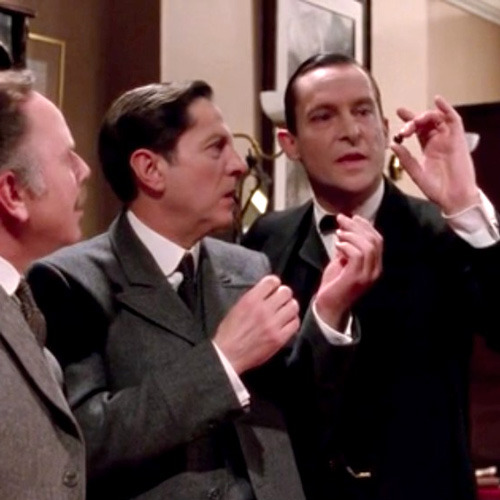

Sherlockian Wednesday Watchalongs: Groundhog Day
By popular demand! (Or maybe… moderate willingness?) It’s the same story, all month long.
All Wednesday watchalong gatherings start at 8:30 pm US Eastern (aka New York) time. (Convert to your local time here.) And remember: the chatroom has moved!
Wednesday, February 1
The Pearl of Death (1944 movie)
Rathbone’s Holmes tackles an adaptation of the The Adventure of the Six Napoleons!
Wednesday, February 8
Sherlock Holmes: The Six Napoleons (1965 TV episode)
Wilmer’s Holmes tackles an adaptation of the The Adventure of the Six Napoleons!
Wednesday, February 15
Granada Holmes: The Six Napoleons (1986 TV episode)
Brett’s Holmes tackles an adaptation of the The Adventure of the Six Napoleons!
Wednesday, February 22
BBC Sherlock: The Six Thatchers (2017 TV episode)
Cumberbatch’s Holmes tackles an adaptation of the The Adventure of the Six Napoleons!
Here’s the deal: Like Sherlock Holmes? You’re welcome to join us in The Giant Chat of Sumatra’s #giantchat text channel to watch and discuss with us. Just find a copy of the episode or movie we’re watching, and come make some goofy internet friends.
Keep an eye on my #the giant chat of sumatra tag and the calendar for updates on future chat events.
#the giant chat of sumatra#sherlock#bbc sherlock#sherlock holmes#the pearl of death#sherlock holmes 1965#granada holmes#the six thatchers#watchalong#click the link above or visit#finalproblem.tumblr.com/chat#for the new giant chat invite link
24 notes
·
View notes
Text
2023 Oscars Trivia (Post-Ceremony)
Like last year, the Best Picture winner had a big night: Oppenheimer won 7 awards, as did Everything Everywhere All at Once. This post will use the word "consecutive" a lot.
This is the second consecutive year that a film won 7+ awards. The last time that happened was 1996-1998 (The English Patient; Titanic; Shakespeare in Love).
This is the second consecutive year that a film has won multiple acting awards. The last time that happened was 2003 & 2004 (Mystic River and Million Dollar Baby). The only other time consecutive Best Picture winners won multiple acting awards was 1953 & 1954 (From Here to Eternity and On the Waterfront).
Four consecutive Best Picture winners have won for acting, the longest streak since 1998-2002.
Oppenheimer is the first film since The Artist (2011) to win both Best Picture and Best Actor.
Oppenheimer is the 6th film to win both male acting awards and the first since Dallas Buyers Club (2013). The last Best Picture winner to win both male acting awards was Ben-Hur (1959).
Three of this year's acting winners have starred in superhero films: Emma Stone was Gwen Stacy in The Amazing Spider-Man, Cillian Murphy was Scarecrow in the Nolan Batman movies, and Robert Downey Jr., of course, is Iron Man.
Oppenheimer is the highest-grossing Best Picture winner since The Lord of the Rings: The Return of the King (2003).
Three Best Picture nominees went home empty-handed: Killers of the Flower Moon, Maestro, and Past Lives.
Killers of the Flower Moon is the third Scorsese film to receive 10 nominations and 0 awards (Gangs of New York, 2002; The Irishman, 2019).
Diane Warren continues to hold the record for most Original Song nominations without a win (15) and continues to be the woman with the most Oscar nominations without a win. She has lost six in a row.
Bradley Cooper is now tied for 8th place among individuals with the most nominations without a win (12).
Despite several nominations -- Martin Scorsese and Robert De Niro for Killers of the Flower Moon, and Matteo Garrone's Io Capitano for International Feature -- none of the men behind Goncharov took home an Oscar.
This is the 8th consecutive year with at least one black winner, extending the record.
Da'Vine Joy Randolph is the 10th black woman to win Best Supporting Actress -- the first acting category to hit double digits.
This is the fourth consecutive year with at least one non-white acting winner (Michelle Yeoh and Ke Huy Quan in 2022; Will Smith and Ariana DeBose in 2021; Daniel Kaluuya and Youn Yuh-jung in 2020) -- the longest streak ever.
Cord Jefferson is the 8th black screenplay winner, and this is the 6th such win (all but one were for Adapted Screenplay).
This is the fourth year in a row that a woman has won a screenplay award (Justine Triet for Anatomy of a Fall, Sarah Polley for Women Talking, Sian Heder for CODA, Emerald Fennell for Promising Young Woman) -- the longest streak ever.
Both screenplay wins were the only wins for their films, and both wins included the film's director. This is the 9th year in a row that a director has won for Original Screenplay, and the 6th year in a row for Adapted Screenplay; both are records.
Kiyoko Shibuya is the third woman and first woman of color to win for Visual Effects (Suzanne M. Benson for Aliens, 1986; Sara Bennett for Ex Machina, 2015).
Neil Corbould, nominated for The Creator, Mission: Impossible - Dead Reckoning Part I, and Napoleon, is the first person to lose for Visual Effects three times in one year (don't worry, he's already won twice).
Billie Eilish (22) and Finneas O'Connell (26) are the youngest people to win multiple Oscars ("No Time to Die" from No Time to Die, 2021).
At 35, Emma Stone is the 8th-youngest person and woman to win two acting Oscars, and the 7th-youngest to win Best Actress twice.
Cillian Murphy is the first Irish Best Actor winner.
Christopher Nolan was the only individual to win multiple awards (Picture and Director).
Christopher Nolan is the first white man to win Best Director solo since Damien Chazelle (La La Land, 2016). Including Daniel Scheinert for Everything Everywhere All at Once, this is the first time since 2010 & 2011 that white men have won Best Director in consecutive years (Tom Hooper for The King's Speech; Michel Hazanavicius for The Artist), and that consecutive Best Picture winners have had a white male director.
The Zone of Interest is the first film from the United Kingdom to win Best International Feature. It is the fifth Best Picture nominee in six years to win in this category, and the third in a row (Drive My Car and All Quiet on the Western Front).
20 Days in Mariupol is the first Ukrainian film to win an Oscar.
Takashi Yamazaki is the second director to win for Visual Effects (Stanley Kubrick for 2001: A Space Odyssey, 1968).
Godzilla Minus One is the first Godzilla film to win an Oscar and the first Japanese film to win for Visual Effects (Tora! Tora! Tora!, 1970, was an American-Japanese co-production). Previously, the only Asian Visual Effects winner was Taiwanese-American Doug Chiang (Death Becomes Her, 1992).
This is the second time that only one non-Best Picture nominee won in a main category (i.e. excluding Animated, Documentary, International, shorts). The other time was 1997 (Best Makeup for Men in Black); notably, that was the year Titanic tied the record for most awards.
This is the second year in a row that the most-nominated film a) won Best Picture and b) won the most awards of the night. The last time consecutive most-nominated films won the most awards was 2016 & 2017 (La La Land and The Shape of Water); the last time consecutive most-nominated films won Best Picture was 2009 & 2010 (The Hurt Locker and The King's Speech).
This is the second consecutive year that multiple films have won 4+ awards (Everything Everywhere All at Once and All Quiet on the Western Front). The last year with multiple 4+ winners was 2014 (Birdman and The Grand Budapest Hotel), and the last time it happened consecutively was 2010 & 2011 (The King's Speech and Inception; The Artist and Hugo).
This is the third consecutive year that three or fewer films have won multiple awards, the longest streak since 1956-1960.
Two couples shared wins: Christopher Nolan & Emma Thomas for Best Picture, and Justine Triet & Arthur Harari for Original Screenplay.
Christopher Nolan & Emma Thomas are the third couple to share a Best Picture win (Richard D. Zanuck & Lili Fini Zanuck, Driving Miss Daisy, 1989; Peter Jackson & Fran Walsh, The Lord of the Rings: The Return of the King, 2003).
Justine Triet & Arthur Harari are the third couple to win for Original Screenplay (Muriel & Sydney Box, The Seventh Veil, 1946; Earl W. & Pamela Wallace, Witness, 1985).
Toshio Suzuki is the second Asian winner of Animated Feature, and Hayao Miyazaki is the first Asian to win twice (Spirited Away, 2002).
The Boy and the Heron and Spirited Away are the only two hand-drawn animated films and the only two non-English-language films to win Animated Feature.
Pixar has lost Animated Feature three years in a row, its longest drought ever.
Holly Waddington is the first person since Mark Bridges (The Artist, 2011) to win Best Costume Design for her first nomination.
#oscars project 2023#oscars trivia#apparently i'm into streaks this year#and the award for most consecutive uses of consecutive goes to...
2 notes
·
View notes
Text
Week 9: I identify as He/Him/Gamer
For years, gamers have been stereotyped as basement dwellers glued to screens, their hobbies dismissed as unproductive and isolating. But what if the secret weapon to shattering this image lies within gaming itself? The rise of social gaming could be the key to showing the world that gamers are actually, well, social butterflies.

I have been in the "sport" since Napoleon's time (JK, since primary school), fought thousands of battles (virtual), earned millions (in-game currency) in reward, and eliminated hundred of thousands of competitors (gamers). Yet I find this week's topic is extremely familiar with me and is the most enjoyable ones so far.
Gaming, or "playing video games", a simple notion, however, allow me to define the term. After examining definitions crafted by Suits (1967) and Carse (1986), I define the particular term as when you choose to overcome unnecessary challenges in order to achieve a specific goal, following the rules of the game. The rules limit you to using less efficient methods instead of easier ones, and you accept the rules because they allow the game to exist. Well, who knew a fun pastime like that could have such a fancy dictionary entry? All this fancy talk for just playing video games? Sign me up!
And, Acaster (2022) listed out 5 reasons why gaming activities occur in our lives, those reasons are Novelty: the chance to experience new worlds and situations; Mastery: the satisfaction of improving skills and overcoming challenges; Freedom: the ability to explore and make choices within a game environment; Risk taking: the opportunity to take calculated risks without real-world consequences; A safe place to fail: you can take as many risks as you want, a much safer place to fail than in the physical world.
Alongside these factors, there are also several reasons for playing video games according to (Howarth, 2022)

Top six reasons given for playing video games as of February 2021 (Howard, 2021)
Furthermore, in contrast to the prevailing notion of gaming as unproductive and isolating over the past two decades, the landscape has undergone a remarkable shift. Modern-day gamers now have the opportunity to turn their passion into a lucrative venture by livestreaming their gameplay on popular platforms like YouTube, Twitch, and TikTok.

Video game livestreaming has revolutionized the way we experience and engage with gaming. As a part-time streamer, I can reflect on the fascinating journey of this phenomenon, as explored in Taylor (2018)'s paper. Livestreaming platforms like Twitch have become virtual arenas where players showcase their skills, entertain audiences, and create communities (Taylor, 2018). The author's research highlights the power of livestreaming as a unique form of media event, capturing the attention of millions of viewers worldwide (only if you are a global streamer with big fame, not my case!). The fusion of gaming, the internet, and computer-mediated communications has given birth to vibrant communities and transformed the spectatorship experience. Just like myself and countless others, livestreaming enthusiasts find themselves immersed in a shared virtual space, executing captivating gameplay while actively engaging with fellow viewers through chat streams (Taylor, 2018).
Beyond Twitch, TikTok has become a surprising hotspot for video game livestreaming. For the past five months, I've been diving into the world of Red Dead Redemption 2, livestreaming my gameplay and using my background in media and the industry to explore viewer engagement. Like El Afi and Ouiddad (2021), I'm fascinated by the motivations that drive people to watch video game streams. Their research suggests viewers are drawn in by a mix of factors, from wanting to learn new strategies (cognitive) to simply enjoying the social and emotional experience (social and affective).

Boldly, live streams are not just one-way broadcasts. Chat explodes with real-time interaction, thanks to viewers firing off questions, comments, and gameplay discussions (like a digital cheering section) (El Afi & Ouiddad, 2021). This keeps things dynamic, as viewers and streamers exchange ideas and build a community. Lastly, the paper highlights this, along with the gamification features on these platform - subscriptions, donations, and reward systems. These features act like virtual high fives, rewarding viewers for their support and fueling a sense of community and loyalty (El Afi & Ouiddad, 2021).
References
Acaster, D. S. (2022). The Psychology of Gaming – Why do people play games? Info.outschool.com. https://info.outschool.com/uk-blog/the-psychology-of-gaming-why-do-people-play-games
Carse, J. P. (1986). FINITE and INFINITE GAMES A Vision of Life as Play and Possibility.
El Afi, F., & Ouiddad, S. (2021). The Rise of Video-Game Live Streaming: Motivations and Forms of Viewer Engagement. HCI International 2021 - Posters, 156–163. https://doi.org/10.1007/978-3-030-78645-8_20
Howarth, J. (2022). How Many Gamers Are There? (New 2023 Statistics). Exploding Topics. https://explodingtopics.com/blog/number-of-gamers#gamer-demographics
Suits, B. (1967). What Is a Game? Philosophy of Science, 34(2), 148–156. https://doi.org/10.1086/288138
0 notes
Text
History
September 2, 31 B.C. - Roman legions under Augustus Caesar defeated Mark Anthony's naval force at Actium.
September 2, 1666 - The Great Fire of London began in a bakery in Pudding Lane near the Tower. Over the next three days more than 13,000 houses were destroyed, although only six lives were believed lost.
September 2, 1752 - The British ended their use of the Julian calendar, switching instead to the Gregorian calendar, resulting in a major adjustment as Wednesday, September 2, was followed by Thursday, September 14. The correction resulted in rioting by people who felt cheated and demanded the missing eleven days back.
September 2, 1789 - The third Presidential cabinet department, the U.S. Treasury, was established by Congress.
September 2, 1864 - During the American Civil War, Atlanta was captured by Sherman's Army. "Atlanta is ours, and fairly won," General William T. Sherman telegraphed President Lincoln.
September 2, 1870 - Napoleon III surrendered to the Prussians during the Battle of Sedan, resulting in the fall of the Second French Empire.
September 2, 1923 - The first elections were held in the Irish Free State after achieving independence from Britain.
September 2, 1930 - French aviators Dieudonne Coste and Maurice Bellonte made the first non-stop flight from Europe to the USA.
September 2, 1945 - President Harry Truman declared V-J Day (Victory over Japan Day) commemorating the formal Japanese surrender to the Allies aboard the USS Missouri in Tokyo Bay.
September 2, 1945 - Ho Chi Minh proclaimed the independence of Vietnam and the establishment of the Democratic Republic of Vietnam.
September 2, 1962 - Soviet Russia agreed to send arms to Cuba, leading to the October Missile Crisis after the shipments were discovered by the U.S.
September 2, 1963 - Alabama Governor George Wallace forcibly halted public school integration by encircling Tuskegee High School with state troopers.
Birthday - Christa McAuliffe (1948-1986) was born in Boston (as Sharon Christa Corrigan). On January 28, 1986, the 37-year-old high-school teacher, the first "ordinary citizen" in space, died with six crew members in the Space Shuttle Challenger explosion.
0 notes
Text
175+ non-Western literature recommendations to diversify your academia, organized by continent + country
I love world literature, and I’ve been frustrated by the lack of representation of it in literature + academia communities on tumblr, so here are some recommendations. I haven’t read all of these myself yet, but the ones I have are excellent and the ones I haven’t come highly recommended from Goodreads and are on my to-read list!
With the exception of anthologies of older works, all of these books were written before 2000 (some literally thousands of years earlier), since I’m less familiar with super contemporary literature. Also, I only included each writer once, though many of them have multiple amazing books. I’m sure there are plenty of incredible books I’m missing, so please feel free to add on to this list! And countries that aren’t included absolutely have a lot to offer as well--usually, it was just hard to find books available in English translation (which all of the ones below are.)
List below the cut (it’s my first post with a cut so let’s hope I do it right... and also warning that it’s super long)
ASIA:
Bangladesh:
Pather Panchali by Bibhutibhushan Bandyopadhyay (1929)
China:
Tao Te Ching by Lao Tzu (6th century BCE)
The Art of War by Sun Tzu (5th century BCE)
The Analects by Confucius (circa 5th-4th century BCE?)
The Book of Chuang Tzu by Zhuangzi (4th century BCE)
Mencius by Mencius (3rd century BCE)
The Songs of the South: An Anthology of Ancient Chinese Poems by Qu Yuan and Other Poets (2nd century AD)
Li Po and Tu Fu: Poems by Li Po and Tu Fu (written 8th century AD)
Poems of Wang Wei (8th century AD)
Romance of the Three Kingdoms by Luo Guanzhong (14th century AD)
Strange Tales from a Chinese Studio by Pu Songling (1740)
Dream of the Red Chamber by Xueqin Cao (1791)
Six Records of a Floating Life by Shen Fu (1809)
Diary of a Madman and Other Stories by Lu Xun (1918)
Mr Ma and Son by Lao She (1929)
Family by Ba Jin (1933)
Love in a Fallen City by Eileen Chang (1943)
A Source Book in Chinese Philosophy by Wing-Tsit Chan (1963)
Red Sorghum by Mo Yan (1987)
Soul Mountain by Gao Xingjian (1989)
The Big Red Book of Modern Chinese Literature edited by Yunte Huang (anthology, 2016)
India:
The Rig Vega (1500-1200 BCE)
The Mahabharata and the Bhagavad Gita (around 400 BCE but not known exactly. The Gita is part of the Mahabharata)
The Upanishads (REALLY wide date range)
The Dhammapada (3rd century BCE)
The Fundamental Wisdom of the Middle Way by Nāgārjuna (2nd century AD)
The Recognition of Sakuntala by Kālidāsa (4th century AD)
The Way of the Bodhisattva by Santideva (700 AD)
Gitanjali by Rabindranath Tagore (1910)
Annihilation of Caste by B.R. Ambedkar (1936)
The Discovery of India by Jawaharlal Nehru (1946)
Train to Pakistan by Khushwant Singh (1956)
A Source Book in Indian Philosophy by Sarvepalli Radhakrishnan and Charles Alexander Moore (1957)
Midnight's Children by Salman Rushdie (1981)
A Suitable Boy by Vikram Seth (1993)
Women Writing in India: 600 BC to the Present V: The Twentieth Century by Susie J. Tharu and K. Lalita (1993)
A Fine Balance by Rohinton Mistry (1995)
The God of Small Things by Arundhati Roy (1996)
Interpreter of Maladies by Jhumpa Lahiri (1999)
Indian Philosophy in English: From Renaissance to Independence (anthology, 2011)
Indonesia:
The Weaverbirds by Y.B. Mangunwijaya (1981)
Iran:
Shahnameh: The Persian Book of Kings by Abolqasem Ferdowsi (11th century AD)
The Essential Rumi by Rumi (13th century AD)
The Blind Owl by Sadegh Hedayat (1936)
Savushun by Simin Daneshvar (1969)
My Uncle Napoleon by Iran Pezeshkzad (1973)
Missing Soluch by Mahmoud Dowlatabadi (1979)
Iraq:
Fifteen Iraqi Poets edited by Dunya Mikhail (published 2013 but the poems are 20th century)
Japan:
The Ink Dark Moon: Love Poems by Ono no Komachi and Izumi Shikibu (9th-10th century AD)
The Pillow Book by Sei Shōnagon (1002 AD)
The Tale of Genji by Murasaki Shikibu (1008 AD)
The Tale of the Heike, unknown (12th century AD)
One Hundred Poets, One Poem Each: A Treasury of Classical Japanese Verse (not sure of year)
Essays in Idleness by Yoshida Kenkō (1332)
Kokoro by Natsume Sōseki (1914)
No Longer Human by Osamu Dazai (1948)
Snow Country by Yasunari Kawabata (1948)
The Makioka Sisters by Jun'ichirō Tanizaki (1948)
Confessions of a Mask by Yukio Mishima (1949)
Masks by Fumiko Enchi (1958)
The Woman in the Dunes by Kōbō Abe (1962)
A Personal Matter by Kenzaburō Ōe (1964)
Silence by Shūsaku Endō (1966)
Korea (written before the division into North/South):
The Memoirs of Lady Hyegyong (written 1795-1805)
Lebanon:
Samarkand by Amin Maalouf (1988)
Gate of the Sun by Elias Khoury (1998)
Pakistan:
We Sinful Women: Contemporary Urdu Feminist Poetry (1991)
The Rebel's Silhouette: Selected Poems by Faiz Ahmed Faiz (1991)
The Taste of Words: An Introduction to Urdu Poetry edited by Raza Mir (2014)
Palestine:
Men in the Sun and Other Palestinian Stories by Ghassan Kanafani (1963)
Orientalism by Edward Said (1978)
I Saw Ramallah by Mourid Barghouti (1997)
Mural by Mahmoud Darwish (2000, which technically breaks my rule by a year but it’s great)
Philippines:
Noli Me Tángere by José Rizal (1887)
Saudi Arabia:
Cities of Salt by Abdul Rahman Munif (1984)
Sri Lanka:
Funny Boy by Shyam Selvadurai (1994)
Syria:
Damascus Nights by Rafik Schami (1989)
Taiwan:
Last Words from Montmartre by Qiu Miaojin (1996)
Turkey:
My Name Is Red by Orhan Pamuk (1998)
Vietnam:
Spring Essence: The Poetry of Hô Xuân Huong by Hô Xuân Huong (1801)
The Tale of Kieu by Nguyen Du (1820)
Paradise of the Blind by Duong Thu Huong (1988)
Miscellaneous Asia (country unclear or multiple current day countries):
The Epic of Gilgamesh (circa 1800 BCE)
Myths from Mesopotamia translated by Stephanie Dailey
The Arabian Nights (as early as the 9th century AD, lots of changes over the years)
The Qur’an
AFRICA:
Algeria:
Fantasia: An Algerian Cavalcade by Assia Djebar (1985)
The Bridges of Constantine by Ahlam Mosteghanemi (1993)
Cameroon:
Houseboy by Ferdinand Oyono (1956)
Egypt:
The Tale of Sinuhe and Other Ancient Egyptian Poems 1940 - 1640 B.C. translated by R.B. Parkinson
Palace Walk by Naguib Mahfouz (1956)
The Sinners by Yusuf Idris (1959)
Woman at Point Zero by Nawal El Saadawi (1975)
The Map of Love by Ahdaf Soueif (1999)
Ghana:
Our Sister Killjoy by Ama Ata Aidoo (1977)
Two Thousand Seasons by Ayi Kwei Armah (1979)
In My Father’s House: Africa in the Philosophy of Culture by Kwame Anthony Appiah (1992)
Guinea:
The Radiance of the King by Camara Laye (1954)
Kenya:
A Grain of Wheat by Ngugi wa Thing'o (1994)
The River and the Source by Margaret A. Ogola (1995)
Libya:
The Bleeding of the Stone by Ibrahim al-Koni (1990)
Mali:
The Fortunes of Wangrin by Amadou Hampâté Bâ (1973)
Nigeria:
The Palm-Wine Drinkard by Amos Tutuola (1952)
Things Fall Apart by Chinua Achebe (1958)
Efuru by Flora Nwapa (1966)
The Joys of Motherhood by Buchi Emecheta (1979)
Aké: The Years of Childhood by Wole Soyinka (1981)
Sozaboy: A Novel in Rotten English by Ken Saro-Wiwa (1985)
The Famished Road by Ben Okri (1991)
Senegal:
God’s Bits of Wood by Ousmane Sembène (1960)
So Long a Letter by Mariama Bâ (1981)
Somalia:
Maps by Nuruddin Farah (1986)
South Africa:
When Rain Clouds Gather by Bessie Head (1969)
Fools and Other Stories by Njabulo S. Ndebele (1986)
Sudan:
Season of Migration to the North by Tayeb Salih (1966)
Tunisia:
The Colonizer and the Colonized by Albert Memmi (1957)
Zimbabwe:
The House of Hunger by Dambudzo Marechera (1978)
Nervous Conditions by Tsitsi Dangarembga (1988)
Miscellaneous Africa:
The Granta Book of the African Short Story edited by Helon Habila (2011)
The Penguin Book of Modern African Poetry edited by Gerald Moore and Ulli Beier (1963)
AMERICAS:
Antigua and Barbuda:
A Small Place by Jamaica Kincaid (1988)
Argentina:
Ficciones by Jorge Luis Borges (1944)
Hopscotch by Julio Cortázar (1963)
The Museum of Eterna’s Novel (The First Good Novel) by Macedonio Fernández (1967)
Kiss of the Spider Woman by Manuel Puig (1976)
The Sixty-Five Years of Washington by Juan José Saer (1985)
How I Became a Nun by César Aira (1993)
Thus Were Their Faces by Silvina Ocampo (2015 but written earlier)
Brazil:
Dom Casmurro by Machado de Assis (1900)
Chronicle of the Murdered House by Lúcio Cardoso (1959)
Dona Flor and her Two Husbands by Jorge Amado (1966)
Pedagagy of the Oppressed by Paulo Freire (1968)
The Hour of the Star by Clarice Lispector (1977)
Vast Emotions and Imperfect Thoughts by Rubem Fonseca (1988)
Chile:
The Obscene Bird of Night by José Donoso (1970)
Emergency Poems by Nicanor Parra (1972)
The House of the Spirits by Isabel Allende (1982)
Colombia:
One Hundred Years of Solitude by Gabriel García Márquez (1967)
Cuba:
The Kingdom of This World by Alejo Carpentier (1949)
Cold Tales by Virgilio Piñera (1958)
Dominican Republic:
In the Time of the Butterflies by Julia Alvarez (1994)
Guatemala:
Men of Maize by Miguel Ángel Asturias (1949)
I, Rigoberta Menchú by Rigoberta Menchú (1985)
Guadalupe (part of France but overseas):
I, Tituba, Black Witch of Salem by Maryse Condé (1986)
Haiti:
Breath, Eyes, Memory by Edwige Danticat (1994)
Jamaica:
No Telephone to Heaven by Michelle Cliff (1987)
The True History of Paradise by Margaret Cezair-Thompson (1999)
Martinique (part of France but overseas):
Discourse on Colonialism by Aimé Césaire (1950)
Wretched of the Earth by Frantz Fanon (1961)
Poetics of Relation by Édouard Glissant (1997)
Mexico:
Pedro Páramo by Juan Rulfo (1955)
Aura by Carlos Fuentes (1962)
The Hole by José Revueltas (1969)
Underground River and Other Stories by Inés Arredondo (1979)
The Collected Poems, 1957-1987 by Octavio Paz (1987)
Like Water for Chocolate by Laura Esquivel (1989)
Nicaragua:
Azul by Rubén Darío (1888)
Peru:
The Cardboard House by Martín Adán (1928)
The Time of the Hero by Mario Vargas Llosa (1962)
The Complete Poems by César Vallejo (1968)
St. Lucia:
Omeros by Derek Walcott (1990)
Trinidad and Tobago:
The Black Jacobins: Toussaint L'Ouverture and the San Domingo Revolution by C.L.R. James (1938)
A House for Mr. Biswas by V.S. Naipaul (1961)
Uruguay:
Open Veins of Latin America by Eduardo Galeano (1971)
Venezuela:
Doña Bárbara by Rómulo Gallegos (1929)
Indigenous Writers from Canada and the United States:
American Indian Stories by Zitkála-Šá (Dakota) (1921)
Winter in the Blood by James Welch (Blackfeet and A’aninin) (1974)
Emplumada by Lorna Dee Cervantes (Chumash) (1982)
She Had Some Horses by Joy Harjo (Mvskoke) (1982)
Love Medicine by Louise Erdrich (Chippewa) (1984)
Ceremony by Leslie Marmon Silko (Laguna Pueblo) (1986)
Custer Died for Your Sins by Vine Deloria Jr. (Dakota) (1988)
The Grass Dancer by Susan Power (Dakota) (1997)
Miscellaneous Americas:
And We Sold the Rain: Contemporary Fiction from Central America edited by Rosario Santos (1988)
Short Stories by Latin American Women: The Magic and the Real edited by Celia Correas de Zapata (2003)
Bordering Fires: The Vintage Book of Contemporary Mexican and Chicana and Chicano Literature edited by Cristina García (2006)
#dark academia#light academia#academia aesthetic#academic#academia#academics#studyblr#litblr#reading#books#booklr#literature#world literature#poc literature#writers of color#bookworm#bookaddict
3K notes
·
View notes
Text
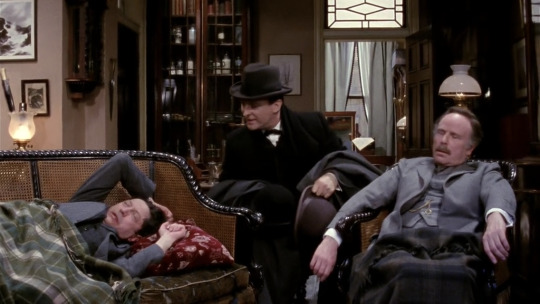
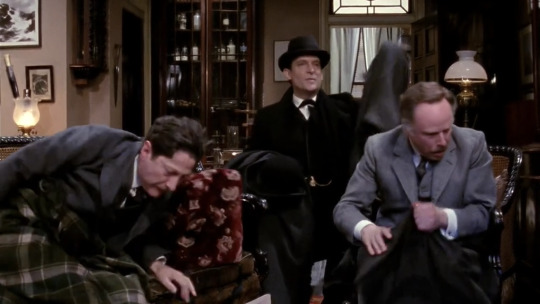


#lestrade just doesn’t get a break does he#daily dose of granada holmes#daily granada screencap#sherlock holmes 1984#the six napoleons 1986#jeremy brett holmes#edward hardwicke watson#colin jeavons lestrade#granada holmes#sherlock holmes#jeremy brett#edward hardwicke#colin jeavons#sherlock holmes granada#dr john watson#john watson#acd holmes#acd sherlock holmes#acd watson#acd john watson#inspector lestrade
309 notes
·
View notes
Photo


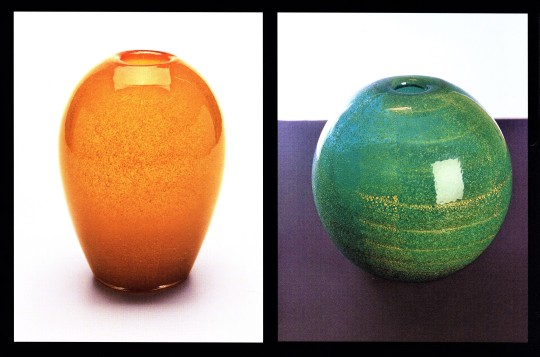
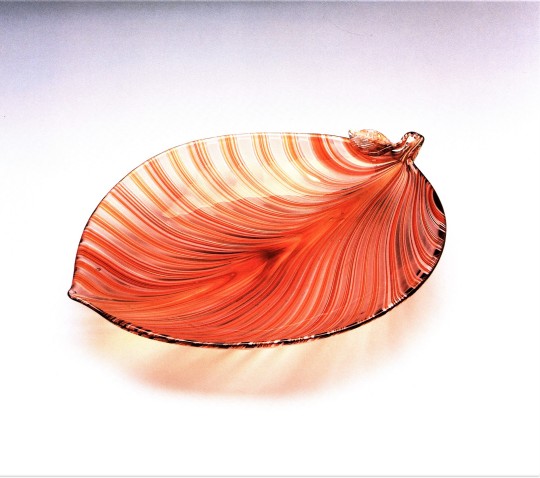






Milestone Monday
On this date, November 8 in 1291, The Republic of Venice enacted a law confining most of Venice's glassmaking industry to the island of Murano. Venetian glassmaking goes back at least as far as the 9th century CE, as testified by an early record, dated 982, containing the first known mention of the name of a glassmaker. While Venetian glassmaking may have originated with the Romans, its ties with medieval Islamic and Byzantine glass production were essential to its becoming, in the 12th century, a highly refined art. By then, Venice had become the glassmaking center of Europe, but the furnaces used to make glass were a potential fire hazard to Venice’s wooden structures, so with the 1291 law, all glassmakers were impelled to remove to the cluster of linked islands known as Murano 1.2 miles north of the city center. There the industry continued to thrive and Murano remains a glassmaking center to this day.
To commemorate this milestone event, we are posting images of 20th-century glassware by the fabled Murano glassworks of Venini, from Venini: Catalogue Raisonné, 1921-1986, edited by the daughter of the company’s founder Anna Venini Diaz de Santillana and published in Milan by Skira in 2000. The name Venini is deeply rooted in the great Murano tradition of glass craftsmanship. The book is an in-depth account of the company established by Paolo Venini in 1921 and carried forward by members of the Venini family up to 1986 when the business was sold off. This comprehensive catalogue contains some 250 descriptions detailing each item produced over six decades of activity, with Anna Venini Diaz de Santillana tracing the history of the 'Vetrerie Venini' glasshouse through each successive master craftsman's term as art director: Napoleone Martinuzzi, Carlo Scarpa, Paolo Venini himself, Tomaso Buzzi, Fulvio Bianconi, and Ludovico Diaz de Santillana. From top to bottom, the works shown here are:
1.) Tomaso Buzzi. Two-spouted vase, 1933.
2.) Napoleone Martinuzzi. Large leaf chandelier, 1928-30.
3.) Carlo Scarpa. 'Sommerso' bubble vases, 1934.
4.) Tyra Lundgren. Leaf, 1938.
5.) Ludovico Diaz de Santillana. 'Murrina' disc, 1962.
6.) Laura Diaz de Santillana. 'Klee' vase, 1978 and Alessandro Diaz de Santillana. 'Coccio' vase, 1984.
7.) Carlo Scarpa. 'Murrina' plates, 1940.
8.) Toni Zuccheri. 'Giada' vase, 1964.
9.) Tomaso Buzzi. 'Alga' vase, 1933.
10.) Toots Zynsky. 'Folto' vases, 1984.
View our other Milestone Monday posts.
#Milestone Monday#milestones#Murano#Murano glass#Venetian glass#Catalogue Raisonné#Venini#Anna Venini Diaz de Santillana#Skira#Paolo Venini#Tomaso Buzzi#Napoleone Martinuzzi#Carlo Scarpa#Tyra Lundgren#Ludovico Diaz de Santillana#Laura Diaz de Santillana#Alessandro Diaz de Santillana#Toni Zuccheri#Toots Zynsky#glassware#glassmaking#glassmakers#Venice
119 notes
·
View notes
Text

Jeremy Brett in "The Six Napoleons" (The Return of Sherlock Holmes, 1986)
#jeremybrett#the return of sherlock holmes#the six napoleons#granada holmes#his face#splendid#my edit
26 notes
·
View notes
Text
Events 4.11
491 – Flavius Anastasius becomes Byzantine emperor, with the name of Anastasius I.
1241 – Batu Khan defeats Béla IV of Hungary at the Battle of Mohi.
1512 – War of the League of Cambrai: Franco-Ferrarese forces led by Gaston de Foix and Alfonso I d'Este win the Battle of Ravenna against the Papal-Spanish forces.
1544 – Italian War of 1542–46: A French army defeats Habsburg forces at the Battle of Ceresole, but fails to exploit its victory.
1689 – William III and Mary II are crowned as joint sovereigns of Great Britain.
1713 – War of the Spanish Succession (Queen Anne's War): Treaty of Utrecht.
1727 – Premiere of Johann Sebastian Bach's St Matthew Passion BWV 244b at the St. Thomas Church, Leipzig
1809 – An incomplete British victory over the French fleet at the Battle of the Basque Roads results in the court-martial of James, Lord Gambier.
1814 – The Treaty of Fontainebleau ends the War of the Sixth Coalition against Napoleon Bonaparte, and forces him to abdicate unconditionally for the first time.
1856 – Second Battle of Rivas: Juan Santamaría burns down the hostel where William Walker's filibusters are holed up.
1868 – Former shōgun Tokugawa Yoshinobu surrenders Edo Castle to Imperial forces, marking the end of the Tokugawa shogunate.
1876 – The Benevolent and Protective Order of Elks is organized.
1881 – Spelman College is founded in Atlanta, Georgia as the Atlanta Baptist Female Seminary, an institute of higher education for African-American women.
1908 – SMS Blücher, the last armored cruiser to be built by the Imperial German Navy, is launched.
1909 – The city of Tel Aviv is founded.
1921 – Emir Abdullah establishes the first centralised government in the newly created British protectorate of Transjordan.
1935 – Stresa Front: opening of the conference between the British Prime Minister Ramsay MacDonald, the Italian Prime Minister Benito Mussolini and the French Minister for Foreign Affairs Pierre Laval to condemn the German violations of the Treaty of Versailles.
1945 – World War II: American forces liberate the Buchenwald concentration camp.
1951 – Korean War: President Truman relieves Douglas MacArthur of the command of American forces in Korea and Japan.
1951 – The Stone of Scone, the stone upon which Scottish monarchs were traditionally crowned, is found on the site of the altar of Arbroath Abbey. It had been taken by Scottish nationalist students from its place in Westminster Abbey.
1952 – Bolivian National Revolution: Rebels take over Palacio Quemado.
1955 – The Air India Kashmir Princess is bombed and crashes in a failed assassination attempt on Zhou Enlai by the Kuomintang.
1957 – United Kingdom agrees to Singaporean self-rule.
1961 – The trial of Adolf Eichmann begins in Jerusalem.
1963 – Pope John XXIII issues Pacem in terris, the first encyclical addressed to all Christians instead of only Catholics, and which described the conditions for world peace in human terms.
1964 – Brazilian Marshal Humberto de Alencar Castelo Branco is elected president by the National Congress.
1965 – The Palm Sunday tornado outbreak of 1965: Fifty-one tornadoes hit in six Midwestern states, killing 256 people.
1968 – President Lyndon B. Johnson signs the Civil Rights Act of 1968, prohibiting discrimination in the sale, rental, and financing of housing.
1968 – Assassination attempt on Rudi Dutschke, leader of the German student movement.
1970 – Apollo Program: Apollo 13 is launched.
1976 – The Apple I is created.
1977 – London Transport's Silver Jubilee AEC Routemaster buses are launched.
1979 – Ugandan dictator Idi Amin is deposed.
1981 – A massive riot in Brixton, south London results in almost 300 police injuries and 65 serious civilian injuries.
1986 – FBI Miami Shootout: A gun battle in broad daylight in Dade County, Florida between two bank/armored car robbers and pursuing FBI agents. During the firefight, FBI agents Jerry L. Dove and Benjamin P. Grogan were killed, while five other agents were wounded. As a result, the popular .40 S&W cartridge was developed.
1987 – The London Agreement is secretly signed between Israeli Foreign Affairs Minister Shimon Peres and King Hussein of Jordan.
1990 – Customs officers in Middlesbrough, England, seize what they believe to be the barrel of a massive gun on a ship bound for Iraq.
1993 – Four hundred fifty prisoners rioted at the Southern Ohio Correctional Facility in Lucasville, Ohio, and continued to do so for ten days, citing grievances related to prison conditions, as well as the forced vaccination of Nation of Islam prisoners (for tuberculosis) against their religious beliefs.
2001 – The detained crew of a United States EP-3E aircraft that landed in Hainan, China after a collision with a J-8 fighter, is released.
2002 – The Ghriba synagogue bombing by al-Qaeda kills 21 in Tunisia.
2002 – Over two hundred thousand people march in Caracas towards the presidential palace to demand the resignation of President Hugo Chávez. Nineteen protesters are killed.
2006 – Iranian president Mahmoud Ahmadinejad announces Iran's claim to have successfully enriched uranium.
2007 – Algiers bombings: Two bombings in Algiers kill 33 people and wound a further 222 others.
2011 – An explosion in the Minsk Metro, Belarus kills 15 people and injures 204 others.
2012 – A pair of great earthquakes occur in the Wharton Basin west of Sumatra in Indonesia. The maximum Mercalli intensity of this strike-slip doublet earthquake is VII (Very strong). Ten are killed, twelve are injured, and a non-destructive tsunami is observed on the island of Nias.
2018 – An Ilyushin Il-76 which was owned and operated by the Algerian Air Force crashes near Boufarik, Algeria, killing 257.
2021 – Twenty year old Daunte Wright is shot and killed in Brooklyn Center, Minnesota by officer Kimberly Potter, sparking protests in the city, when the officer allegedly mistakes her own gun for her taser.
1 note
·
View note
Text
Гранадовский сериал
Здесь собраны ссылки на мои отзывы на каждую серию гранадовского сериала про Шерлока Холмса с Джереми Бреттом. Посмотреть всю ленту постов-отзывов можно по моему тегу #Granada Holmes.
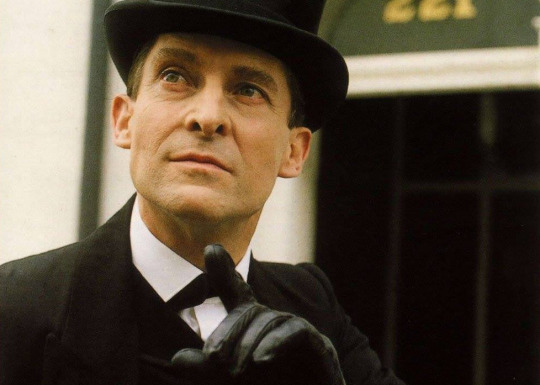
The Adventures of Sherlock Holmes (1984 - 1985)
1x01 - A Scandal in Bohemia
1x02 - The Dancing Men
1x03 - The Naval Treaty
1x04 - The Solitary Cyclist
1x05 - The Crooked Man
1x06 - The Speckled Band
1x07 - The Blue Carbuncle
2x01 - The Copper Beeches
2x02 - The Greek Interpreter
2x03 - The Norwood Builder
2x04 - The Resident Patient
2x05 - The Red-Headed League
2x06 - The Final Problem
The Return of Sherlock Holmes (1986 - 1988)
3x01 - The Empty House
3x02 - The Abbey Grange
3x03 - The Musgrave Ritual
3x04 - The Second Stain
3x05 - The Man with the Twisted Lip
3x06 - The Priory School
3x07 - The Six Napoleons
4x01 - The Sign of Four (полнометражный фильм)
4x02 - The Devil's Foot
4x03 - The Silver Blaze
4x04 - Wisteria Lodge
4x05 - The Bruce Partington Plans
4x06 - The Hound of the Baskervilles (полнометражный фильм)
The Case-Book of Sherlock Holmes (1991 - 1993)
5x01 - The Disappearance of Lady Frances Carfax
5x02 - The Problem of Thor Bridge
5x03 - Shoscombe Old Place
5x04 - The Boscombe Valley Mystery
5x05 - The Illustrious Client
5x06 - The Creeping Man
6x01 - The Master Blackmailer (полнометражный фильм)
6x02 - The Last Vampyre (полнометражный фильм)
6x03 - The Eligible Bachelor (полнометражный фильм)
The Memoirs of Sherlock Holmes (1994)
7x01 - The Three Gables
7x02 - The Dying Detective
7x03 - The Golden Pince-Nez
7x04 - The Red Circle
7x05 - The Mazarin Stone
7x06 - The Cardboard Box
Bonus
1988 - The Case of the Abbey Treasure (2-минутный рекламный спешл)
1989 - The Secret of Sherlock Holmes (аудиозапись спектакля)
1992 - The Four Oaks Mystery (10-минутный эпизод телемарафона)
1984 - Joy to the World - A Celebration of Christmas (рождественский спешл)
6 notes
·
View notes
Photo



Sherlockian Wednesday Watchalongs: Groundhog Day
Granada Holmes: The Six Napoleons (1986 TV episode)
Didn’t… Didn’t we just do this?

We’ll watch and chat live at 8:30 pm US Eastern time (click for your local date/time). And remember: the chatroom has moved to Discord!
Anyone is welcome to join us, even if you've randomly discovered this post. See you in The Giant Chat of Sumatra!
#the giant chat of sumatra#sherlock#bbc sherlock#sherlock holmes#granada holmes#watchalong#click the link above or visit#finalproblem.tumblr.com/chat#for the new giant chat invite link
15 notes
·
View notes